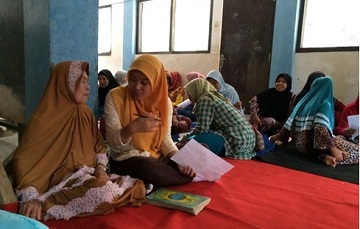Students of IPB Launched the Receipt to Save Electricity

The improvement to the electrical needs could trigger the occurrence of the electrical energy crisis. The government (PT. PLN) had sought a variety of ways to meet the electrical needs of the population of Indonesia. However, the government (PT. PLN) could not be alone to meet the electrical needs per year.
Reflecting on the condition, a number of the students of Bogor Agricultural University (IPB) incorporated in the Student Creativity Program (PKM) headed by Dinda Ratnasari (a student of Department of Economy and Enviromental Resources, Faculty of Economics and Management – FEM) proposed a new breakthrough as an effort to save the electrical energy. This new breakthrough was named “Setitik” in the form of the innovation of the making of the electricity saving receipt.
The team with the members of Eka Listiani (Faculty of Mathematics and Natural Sciences – FMIPA), Vara Dita Puri Ningtyas (Faculty of Forestry), Erika Nurdajhmi Laela and Dwi Wara Widiyaningtyas (FEM) were under the guidance of Dr. Aceng Hidayat and Prima Gandhi, SP MSi.
This electrical receipt was made different from the electrical receipt commonly used by PT. PLN. “Setitik” was a specially designed eletrical receipt by including the electricity bills of the community accompanied by the the total consumption of the eletrical energy per kWH that had been used, as well as attaching the total usage or bills of the local residents in one complex per one month. The back of the receipt was also equipped with the tips and the tricks on how to save the electricity. The making of this electricity saving receipt was supported by PT. PLN of Bogor District and Ministry of Energy and Mineral Resources (ESDM).
There were three kinds of the electrical receipts namely red, yellow, green receipts which could be used as the benchmark to indicate whether the household was saving the electricity or not. Red was for the above average usage (wasteful), yellow was for the use of the same with the average, and green was the use of below average (frugal). “The use of different colors in this receipt is expected to change the behavior of the community which is still wasteful in the use of the electrical energy,” said Dinda.
The implementation of the program of “Setitik” was done to the community of Cihideung Udik Village, Dramage Subdistrict, Bogor District. The condition of the community here was still minimal knowledge on the use of the electrical energy effectively and efficiently, and it still had the habit of using the electricity uncontrollably. This resulted the cost of the electricity bills swell, while on the other side the economic condition of the majority of middle to lower community was needed the education about the effective electricity usage, so that the community could control the electricity usage.
The provision of the electricity saving receipt was an effort to make the electrical energy saving through an economic behavior approach. The program was done by the way to provide the education to the community on how to save the electricity by knowing any electronic goods that were potentially large power consuming. “Setitik” provided the tips and the tricks in using the eletrical tools effectively and efficiently. “Setitik” could be the controller and the reminder in the electricity usage per month. “The team of Setitik has been educating us since last March. This education is very useful, after we apply it, the burden of our electricity bill in the past month has decreased”, said one of the recipient community of Setitik receipt.***



